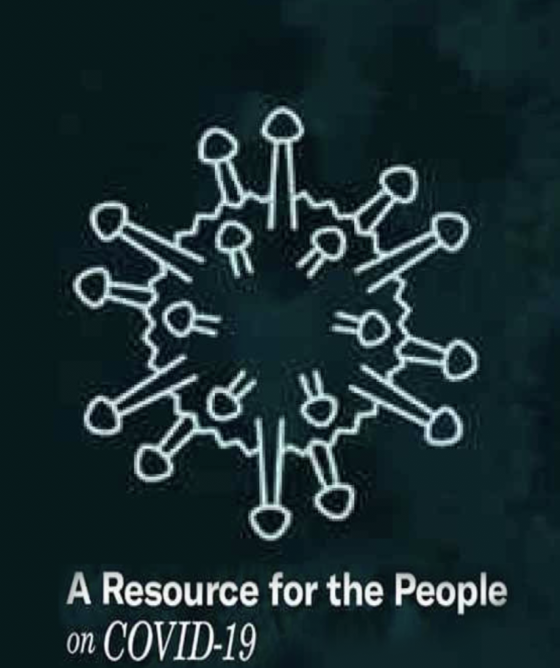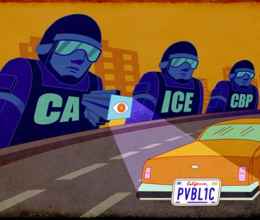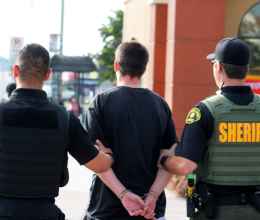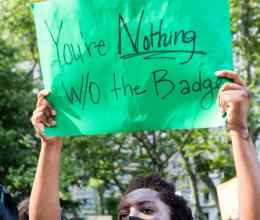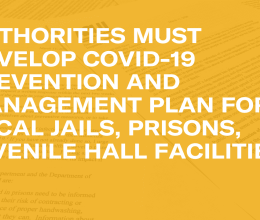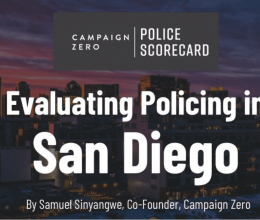SAN DIEGO, CA – Norma Chavez-Peterson, Executive Director of the San Diego ACLU delivered the following statement regarding the final SDSU Study of SDPD Traffic Stop data during the 2pm meeting of the Public Safety & Livable Neighborhoods Committee Meeting today:
Good afternoon, Council President Pro Tem Emerald and members of the committee. My name is Norma Chavez-Peterson. I am the Executive Director of the ACLU of San Diego and Imperial Counties. Thank you for the opportunity to appear before you again to discuss this very important matter. I especially want to thank outgoing Councilmembers Gloria and Emerald for their years of service to the people of San Diego.
We appreciate the work of the researchers at San Diego State University in producing this extensive study. The public has waited several years for empirical information and analysis of San Diego police traffic stop data so that we might understand and address serious concerns about racial profiling. The ACLU comes to today’s meeting to share our views on the 130-page final version, to highlight areas of concern, to raise necessary questions, and to encourage the Mayor and Chief Zimmerman to exercise meaningful leadership in carrying out the Study’s recommendations, including but not limited to implementing AB953 ahead of schedule.
We are not here to villainize our police department or minimize the important work they do every day. We are here to advocate for fair and just policing. We want not only to make sure that officers aren’t acting with racist intent, but also to ensure the effect of biased decision-making is acknowledged and addressed. We all agree that it is unacceptable for Black and Latino drivers to be pulled over, searched and interviewed at higher rates than Whites. But this Study provides tangible evidence that these things indeed occur.
- We are baffled by last month’s initial findings, reiterated in the executive summary of the final Study, as it identified no disparities for Latinos in vehicle stop data in 2014 or 2015. However, in later pages, the Study acknowledged disparities for Latinos regarding searches and field interviews, something we know from the data.
- On page 44, the Study found that Latinos stopped in the Northeastern division were 33.7 percent more likely to be stopped before sundown than after dark.
- And on p. 63, the Study found that Latinos were 37 percent more likely to be searched than Whites.
- We learned that in 2014, Black drivers, age 25 and under, were almost 44 percent more likely to be stopped in daylight than after dark, as compared to young White drivers. (p. 35)
- The fact that Blacks and Latinos were searched at higher rates was true in 2014 and 2015, just as it was in 2000 and 2001 –the last time we looked, 13 years ago. Over the past two years, Black and Latino drivers were searched nearly twice as frequently as White drivers.
- The Southeastern, Central and Southern Divisions have the highest number of incomplete traffic card information and all are located in communities with large populations of people of color. This is especially troubling, as the Study’s authors note, because as a result we may not have an accurate picture of traffic stops involving people of color and stops occurring south of Interstate 8.
- To be clear, it’s quite possible that the problem is greater than what the Study presents.
The Study also shed light on tactics used by SDPD that contribute to racial profiling. Tactics that communities of color have known about for far too long. For example, interviews of police officers yielded statements like:
- “I'm not going to lie. If I see somebody that's totally out of place and there's a reason to stop them, I'm going to stop them and ask them what they're doing.” (p.76)
- Field interviews are “the bread and butter of any gang investigator” and important for identifying criminal suspects. (p.63)
- The Study found that “[o]nly a handful of officers directly stated that race/ethnicity is a factor – whether explicit or implicit – in how traffic stop decisions are made. These officers spoke about the “race/ethnicity out of place” approach, in which officers deliberately target individuals whose race/ethnicity does not fit the dominant demographics of the area.”
Policing tactics such as these serve to validate experiences reported by Black and Brown people who tell us that where one lives influence whether interactions with SDPD are positive or negative. Making traffic stops using the “race out of place” approach as described in the Study violates SDPD’s Non-Bias Based Policing Policy, as well as the U.S. Constitution.
- A person’s zip code should not determine if they are deserving of fair and constitutional policing.
The Study’s methodology, certain word choices, and occasionally unsubstantiated explanations gave us pause as well:
- We question the value of the “veil of darkness” approach for detecting police bias. This methodology assumes that “an officer can see a driver’s race before a stop in daylight hours and cannot see a driver’s race before a stop in darkness hours.” This is a deeply problematic assumption. It ignores the likelihood of ambient lighting.
- In fact, when researchers in Syracuse, NY evaluated the “Veil of Darkness” method, they determined that “ignoring ambient lighting leads to a conclusion of no racial profiling against African-Americans, while accounting for ambient lighting leads to the opposite result.”
- The Study notes that Black and Latino San Diegans tend to live in different neighborhoods from most White and Asian/Pacific Islander San Diegans. The Study points to crime in communities of color as if to justify a heavy police presence.
Just because some drivers live in a working class neighborhood or a neighborhood with higher crime rates does not mean that there should be a “natural” expectation they will have frequent police interaction. How police officers and resources are deployed must be closely examined to understand how they might contribute to racial disparities. This is one lesson that we hope SDPD will consider as it develops its response moving forward. - The City’s November 16 response to the Study indicates that researchers were asked to omit ‘subjective’ terms like ‘much,’ ‘serious,’ and even ‘interesting.’
We find this interesting because it suggests the City wants to downplay the importance of the disparities. I think it would be very helpful to know what the researchers found to be serious.
Which brings us to the BIG question – what are the City and SDPD going to do? The responses provided by the City in their November 16 letter are very general, basically saying “we are going to follow the law.” This is great – we want our police officers to follow the law. We hope to hear today exactly their plans to follow the law and not generic statements.
We agree with many of the Study’s recommendations and urge the PSLN Committee to ask the Mayor and SDPD Chief when and how they will take meaningful action.
- We strongly urge the SDPD to acknowledge and apologize for racial bias. Thus far, the department has acknowledged generalized disparities. But to build public trust, the SDPD must clearly articulate the existence of racial and ethnic disparities in how San Diegans are policed and offer an apology. It is time for SDPD to own the disparities and commit to meaningful changes.
- We strongly support the recommendation to implement the Racial and Identity Profiling Act of 2015 (AB 953), something a number of community members and the ACLU called for during last month’s PSLN meeting.
Regulations for this new law will be completed in early 2017. SDPD should also commit to presenting a report on this data to the City Council annually. Also, any funds needed to comply with the law’s requirements should be included in the Mayor’s FY 2017-18 budget. - We applaud the recommendations regarding additional data collection. We are concerned about the discontinuance of the traffic stop card and would want to ensure that there is a system in place that will collect all of the data before the current system – albeit not perfect – is discarded.
- We also agree with the recommendation that SDPD identify a policy to address how traffic enforcement is done. In our opinion, the City response to this recommendation was unsatisfactory, saying “[t]raffic concerns are among the most prevalent issues voiced at the many community meetings officers attend, and there is an expectation by the public that officers enforce traffic laws to improve public safety.” To us, this suggests the City is ignoring unfavorable findings.
- We urge the City to seriously consider the recommendation to examine the traffic stop practices and implement a policy. The Study reports that “in interviews, SDPD officers described highly varying approaches to and justifications for making traffic stops. Some officers we spoke with frequently described traffic stops as being useful for educational purposes… others touted the investigative usefulness of traffic stops to uncover criminal activity.” We concur with the Study’s concern that this highly-individualized approach to policing can lead to unjustly disparate treatment.
Other questions we hoped to see answered in a more comprehensive study include:
- What are the rates for searches, field interviews, arrests and citations for passengers? As with driver data, capturing race, gender and age is an important aspect of this inquiry.
- Does SDPD have information about the geographic location of traffic specific officers? How many officers are traffic specific officers?
In conclusion, we believe this Study offers the City of San Diego and our police department an extraordinary opportunity to demonstrate real leadership in addressing concerns related to racial profiling. With this goal in mind, the ACLU asks this Committee to do the following:
- Refer this Study to the full City Council and have it heard by February 2017;
- Require the Mayor and SDPD Chief to commit to implement AB 953 once the regulations are finalized;
- Require SDPD to come to the City Council prepared to discuss what new systems, or improvement to existing systems, are needed to collect the data AB 953 will require, and their budgetary needs to comply with the law;
- Require the Mayor and SDPD Chief to commit to producing an annual report with data collected in compliance with the new law;
- Require SDPD to explain how they will address concerns regarding disparities in traffic stops, searches and field interviews
- Require SDPD to identify what type of accountability mechanisms are in place to ensure compliance with traffic card completion; and finally
- Require SDPD to identify how they will incorporate findings from this Study into academy and ongoing training, particularly as it relates to racial profiling, field interviews and consensual searches. SDPD should also identify community partners, with councilmember input, to provide additional trainings to officers.
Thank you for your time and careful consideration of these remarks.
###

